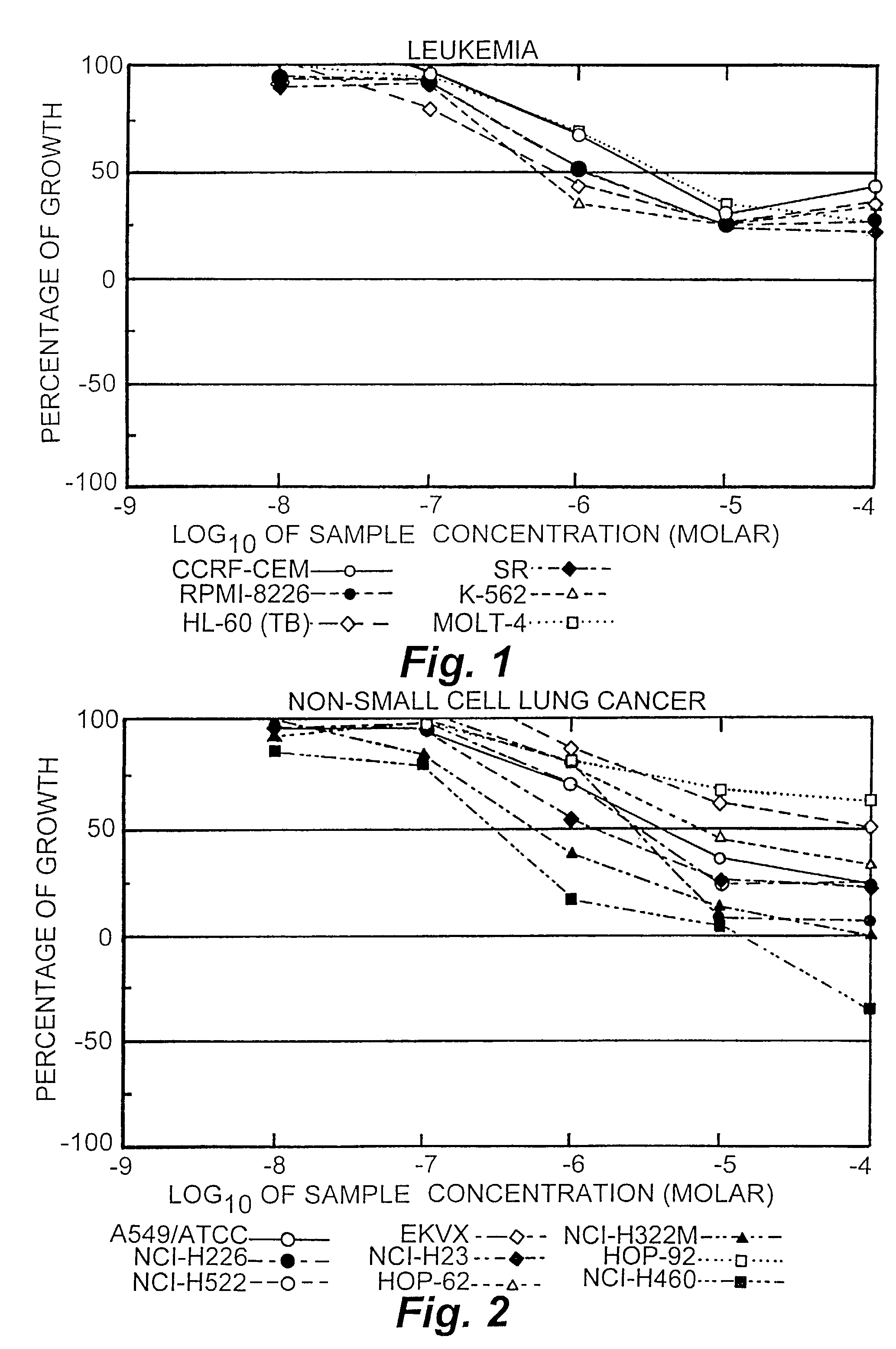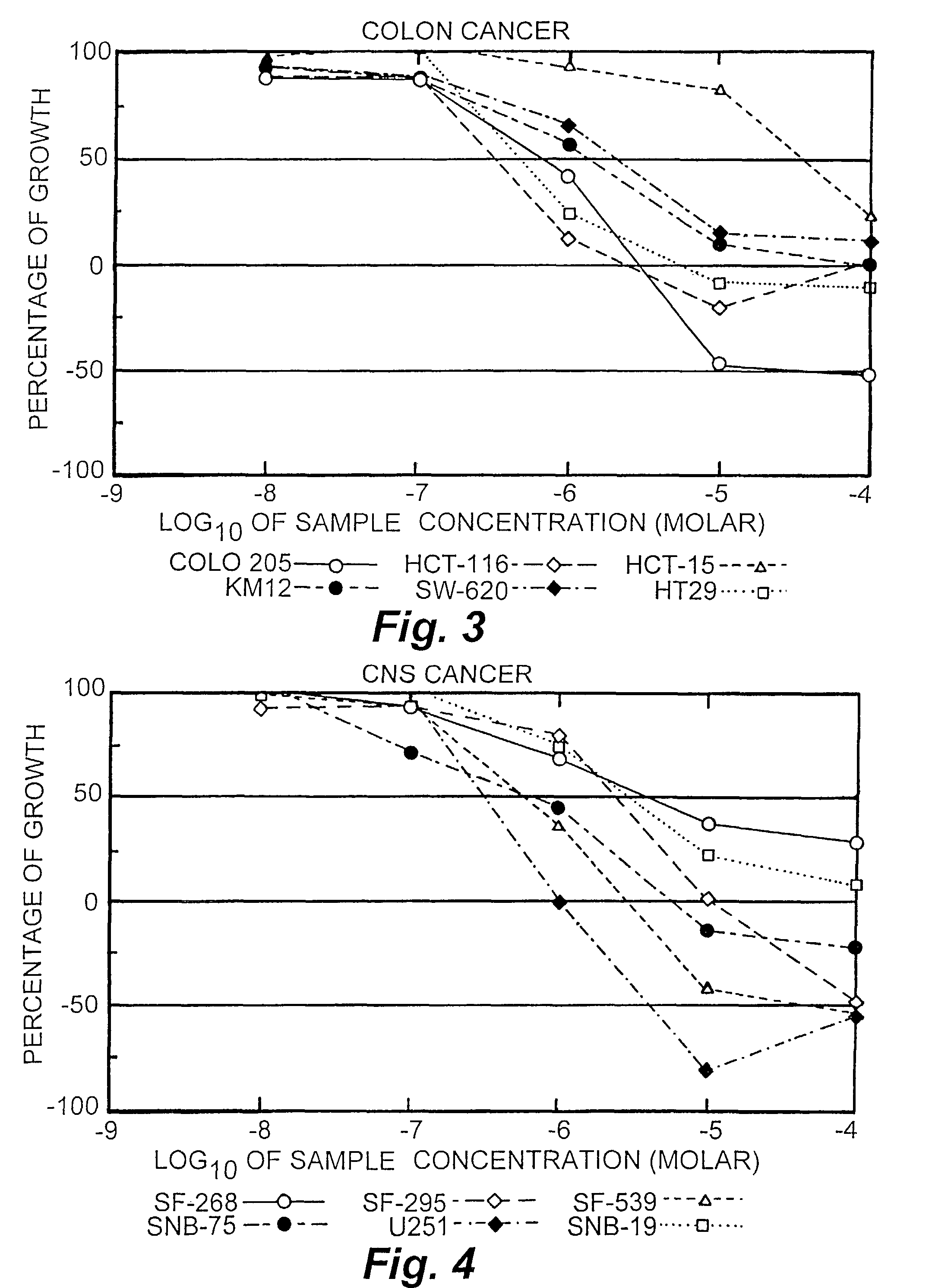Fatty acid-pharmaceutical agent conjugates
a technology of fatty acid and conjugate, which is applied in the field of fatty acidpharmaceutical agent conjugate, can solve the problems of limited therapeutic dose effective for cancer treatment, extreme insolubility of taxol, and significant drawbacks of taxol's ability to fight cancers of diverse tissue origin, so as to reduce the activity of these conjugates, improve the therapeutic index of conjugates, and reduce potential side effects
- Summary
- Abstract
- Description
- Claims
- Application Information
AI Technical Summary
Benefits of technology
Problems solved by technology
Method used
Image
Examples
example 1
[0068]
[0069]A solution of Taxol (41 μmol) in methylene chloride (2.5 mL) under argon was mixed with 4-dimethylaminopyridine (41 μmol), dicyclohexylcarbodiimide (82 μmol), and DHA (41 μmol) and the reaction mixture was stirred at ambient temperature for two hours. Following dilution with ether, the reaction mixture was washed with 5% hydrochloric acid, water, saturated aqueous sodium chloride, dried, and concentrated. Radial chromatography of the residue produced 45 mg (94%) of crystalline Taxol-DHA conjugate 1.
example 2
[0070]
[0071]The production of analog 2 involves several steps including a number of protection-acylation-deprotection steps. A solution of Taxol (59 μmol) in methylene chloride (2.5 mL) was mixed at ambient temperature under argon with imidazole (147 μmol) and triethylsilyl chloride (147 μmol). The reaction mixture was stirred for thirty minutes, diluted with additional methylene chloride, washed with water, saturated aqueous sodium chloride, dried, and concentrated. Chromatography of the residue produced 50 mg (88%) of intermediate A plus 5 mg of the 2′, 7-di(triethylsilyl) ether derivative. A solution of intermediate A (52 μmol) in methylene chloride (3 mL) was mixed at ambient temperature under argon with 4-dimethylaminopyridine (52 μmol), dicyclohexylcarbodiimide (104 μmol), and DHA (52 μmol). The reaction mixture was stirred for ten hours, diluted with ether, passed through celite, and concentrated. Chromatography of the residue produced 65.9 mg of intermediate B. A solution of...
example 3
[0072]Conjugates 1 and 2 were sent to the United States National Cancer Institute (NCI) for screening in the NCI's anticancer screening program. The conjugates were provided in ethanol (approximately 40 mg analog / 2 ml ethanol). The conjugates were sealed in vials under argon to avoid exposure of the conjugates to oxygen because the conjugates were believed to be sensitive to oxygen. Instructions were provided to store at 4° C. and to open the vials only when ready for immediate experimental use. Instructions also were provided to use the ethanol solutions containing the conjugates directly or to dissolve the analogs further in DMSO (dimethylsulfoxide) at appropriate concentrations, with vortexing if necessary for adequate dispersal.
[0073]The activities of conjugates 1 and 2 were tested against 57 cancer cell lines. The results are presented in FIGS. 1-9 for conjugate 1, FIGS. 10-18 for conjugate 2 and FIGS. 19-27 for Taxol. To understand the data, reference is made to the guides pro...
PUM
| Property | Measurement | Unit |
|---|---|---|
| temperature | aaaaa | aaaaa |
| fatty acid | aaaaa | aaaaa |
| strength | aaaaa | aaaaa |
Abstract
Description
Claims
Application Information
 Login to View More
Login to View More - R&D
- Intellectual Property
- Life Sciences
- Materials
- Tech Scout
- Unparalleled Data Quality
- Higher Quality Content
- 60% Fewer Hallucinations
Browse by: Latest US Patents, China's latest patents, Technical Efficacy Thesaurus, Application Domain, Technology Topic, Popular Technical Reports.
© 2025 PatSnap. All rights reserved.Legal|Privacy policy|Modern Slavery Act Transparency Statement|Sitemap|About US| Contact US: help@patsnap.com



